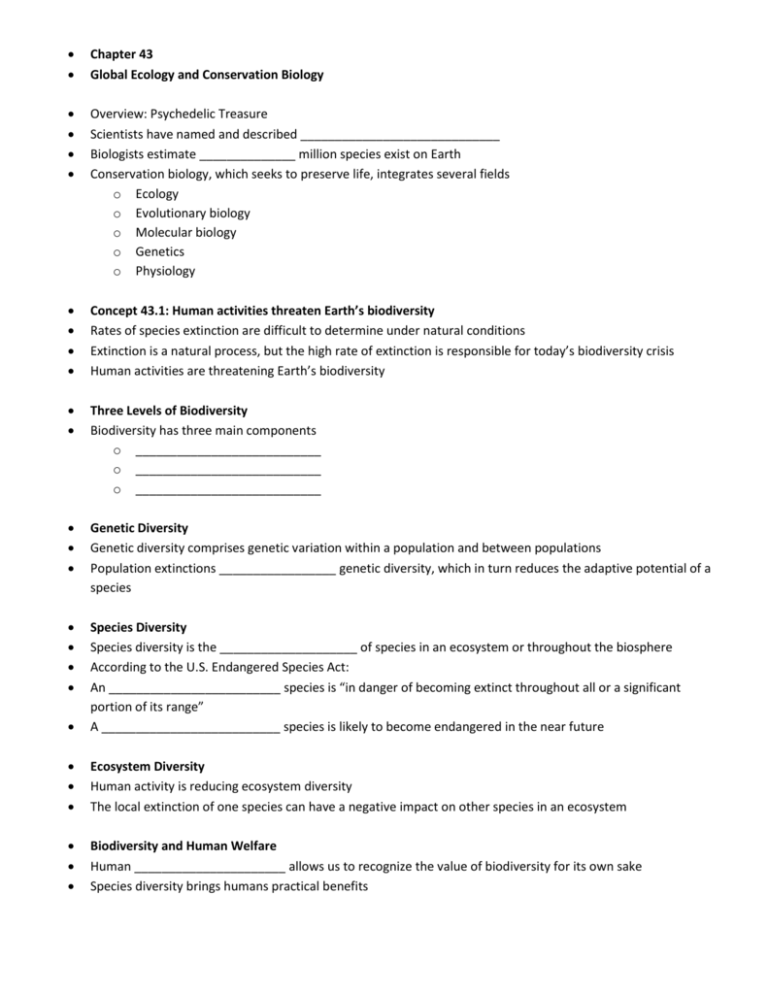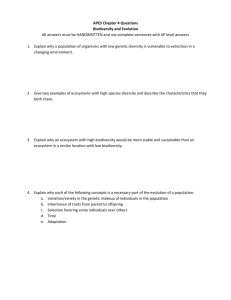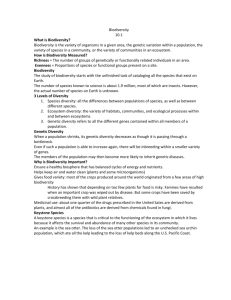Chapter 43
advertisement

Chapter 43 Global Ecology and Conservation Biology Overview: Psychedelic Treasure Scientists have named and described _____________________________ Biologists estimate ______________ million species exist on Earth Conservation biology, which seeks to preserve life, integrates several fields o Ecology o Evolutionary biology o Molecular biology o Genetics o Physiology Concept 43.1: Human activities threaten Earth’s biodiversity Rates of species extinction are difficult to determine under natural conditions Extinction is a natural process, but the high rate of extinction is responsible for today’s biodiversity crisis Human activities are threatening Earth’s biodiversity Three Levels of Biodiversity Biodiversity has three main components o ___________________________ o ___________________________ o ___________________________ Genetic Diversity Genetic diversity comprises genetic variation within a population and between populations Population extinctions _________________ genetic diversity, which in turn reduces the adaptive potential of a species Species Diversity Species diversity is the ____________________ of species in an ecosystem or throughout the biosphere According to the U.S. Endangered Species Act: An _________________________ species is “in danger of becoming extinct throughout all or a significant portion of its range” A __________________________ species is likely to become endangered in the near future Ecosystem Diversity Human activity is reducing ecosystem diversity The local extinction of one species can have a negative impact on other species in an ecosystem Biodiversity and Human Welfare Human ______________________ allows us to recognize the value of biodiversity for its own sake Species diversity brings humans practical benefits Benefits of Species and Genetic Diversity Species related to agricultural crops can have important genetic qualities The enormous genetic diversity of organisms has potential for great human benefit Ecosystem Services Ecosystem services encompass all the processes through which natural ecosystems help sustain human life Some examples of ecosystem services o ___________________________ of air and water o ___________________________ and decomposition of wastes o Crop pollination, pest control, and soil preservation Ecosystem services have an estimated value of $33 trillion per year, but are provided for free. Threats to Biodiversity Most species loss can be traced to four major threats o _____________________________ o _____________________________ o _____________________________ o _____________________________ Habitat Loss Human alteration of habitat is the greatest threat to biodiversity throughout the biosphere In almost all cases, habitat fragmentation and destruction lead to loss of biodiversity Introduced Species Introduced species are those that humans move from native locations to new geographic regions Without their native predators, parasites, and pathogens, introduced species may spread rapidly Introduced species that gain a foothold in a new habitat usually _______________ their adopted community Humans have deliberately introduced some species with good intentions but disastrous effects Overharvesting Overharvesting is human harvesting of wild plants or animals at rates _______________________ the ability of populations of those species to rebound Species with restricted habitats or large body size with low reproductive rates are especially vulnerable to overharvesting DNA analysis can help conservation biologists identify the source of illegally obtained animal products Global Change Global change includes alterations in climate, atmospheric chemistry, and broad ecological systems Acid precipitation is rain, snow, sleet, or fog with a pH < 5.2 Acid precipitation contains ___________________________________ acid from the burning of wood and fossil fuels Concept 43.2: Population conservation focuses on population size, genetic diversity, and critical habitat Biologists focusing on conservation at the population and species levels follow two main approaches o The small-population approach o The declining-population approach Small-Population Approach The small-population approach studies processes that can make small populations become extinct The ___________________________________: Evolutionary Implications of Small Population Size A small population is prone to inbreeding and genetic drift, which draw it down an extinction vortex The key factor driving the extinction vortex is loss of the ___________________________ necessary to enable evolutionary responses to environmental change Small populations and low genetic diversity do not always lead to extinction Declining-Population Approach The declining-population approach Focuses on threatened and endangered populations that show a downward trend, regardless of population size Emphasizes the ____________________________________________ that caused a population to decline Concept 43.3: Landscape and regional conservation help sustain biodiversity Conservation biology has attempted to sustain the biodiversity of entire communities, ecosystems, and landscapes Ecosystem management is part of landscape ecology, which seeks to make biodiversity conservation part of land-use planning Establishing Protected Areas Conservation biologists apply understanding of landscape dynamics in establishing protected areas to slow the loss of biodiversity Preserving Biodiversity Hot Spots A biodiversity _____________________________ is a relatively small area with a great concentration of endemic species and many endangered and threatened species Biodiversity hot spots are good choices for nature reserves, but identifying them is not always easy Designation of hot spots is often biased toward saving vertebrates and plants Concept 43.4: Earth is changing rapidly as a result of human actions The locations of reserves today may be unsuitable for their species in the future Human-caused changes in the environment include o ___________________________________ o ___________________________________ o ___________________________________ Concept 43.5: The human population is no longer growing exponentially but is still increasing rapidly Global environmental problems arise from growing consumption and the increasing human population No population can grow indefinitely, and humans are no exception The Global Human Population The human population increased relatively slowly until about 1650 and then began to grow exponentially The global population is now more than ______________________ Though the global population is still growing, the rate of growth began to slow during the 1960s The growth rates of individual nations vary with their degree of _______________________________________ Most of the current global population growth is concentrated in developing countries Human population growth rates can be controlled through family planning, voluntary contraception, and increased access to education for females Global Carrying Capacity How many humans can the biosphere support? Population ecologists predict a global population of ________________________________ people in 2050 Estimates of Carrying Capacity The carrying capacity of Earth for humans is uncertain The average estimate is _______________________________ Limits on Human Population Size The ecological footprint concept summarizes the aggregate _______________________________ area needed to sustain the people of a nation It is one measure of how close we are to the carrying capacity of Earth Countries vary greatly in footprint size and available ecological capacity Concept 43.6: Sustainable development can improve human lives while conserving biodiversity The concept of _________________________________ helps ecologists establish long-term conservation priorities Sustainable Development Sustainable development is development that meets the needs of people today without limiting the ability of future generations to meet their needs.








